Abstract
(R)-2-Benzyl-5-cyano-4-oxopentanoic acid (compound 4) was studied as a mechanism-based inactivator (suicide substrate) for the zinc protease carboxypeptidase A (CPA; peptidyl-L-amino-acid hydrolase, EC 3.4.17.1). This compound was designed rationally based on the knowledge of the active site topology and the reported stereospecific proton exchange on ketonic substrate analogue (R)-3-(p-methoxybenzoyl)-2-benzylpropanoic acid [Sugimoto, T. & Kaiser, E. T. (1978) J. Am. Chem. Soc. 100, 7750-7751] by CPA. It is suggested that enzymic deprotonation on the C-5 methylene moiety may result in the transient formation of a ketenimine as the key intermediate that partitions between turnover and enzyme inactivation. The enzyme inactivation exhibited pseudo-first-order kinetics, was irreversible, and could be fully prevented in the presence of the reversible inhibitor benzyl-succinate. The inactivation rate constant, kintact, was evaluated to be 0.083 +/- 0.003 min-1 and kcat was measured at 1.78 +/- 0.06 min-1. In turn, a partition ratio of 28 +/- 3 was calculated. The reversible inhibitor constant (Ki) was measured at 1.8 +/- 0.5 microM, indicative of a high affinity for compound 4 shown by CPA; however, Km for the turnover process was determined at 4.93 +/- 0.43 mM. Kinetic analysis and labeling by the radioactive form of the inactivator suggested that the stoichiometry for protein modification by compound 4 approaches a 1:1 ratio.
Full text
PDF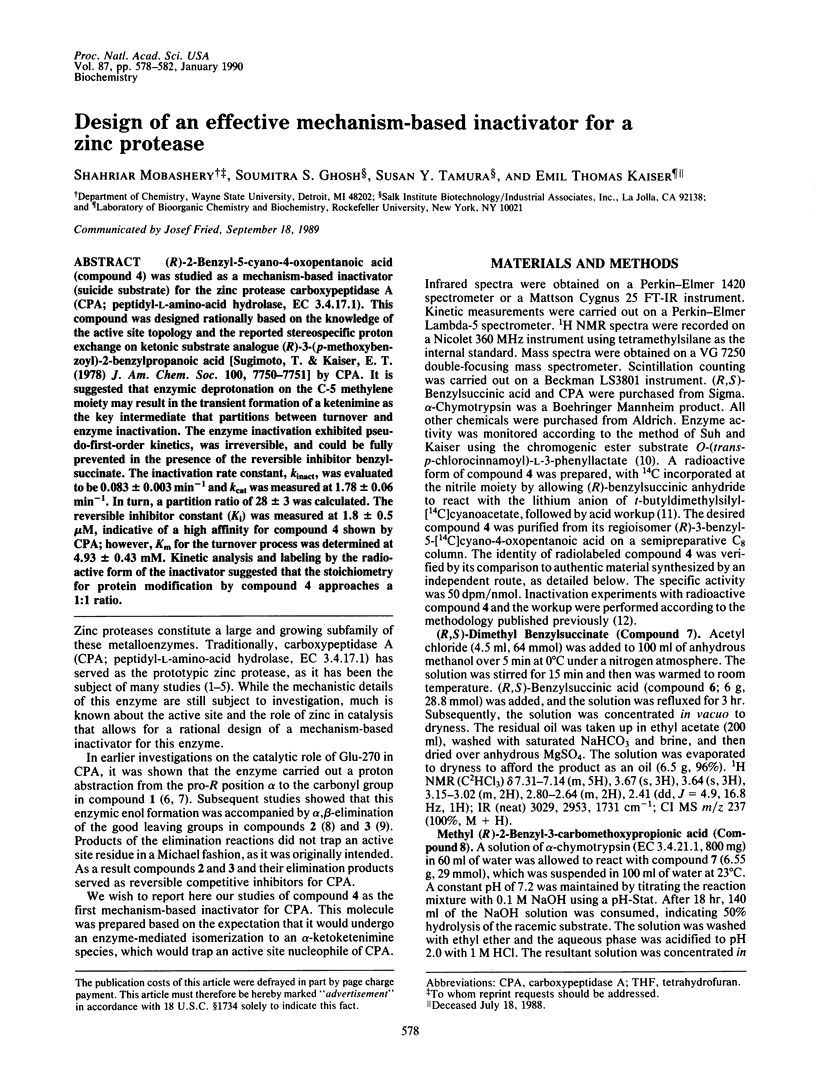
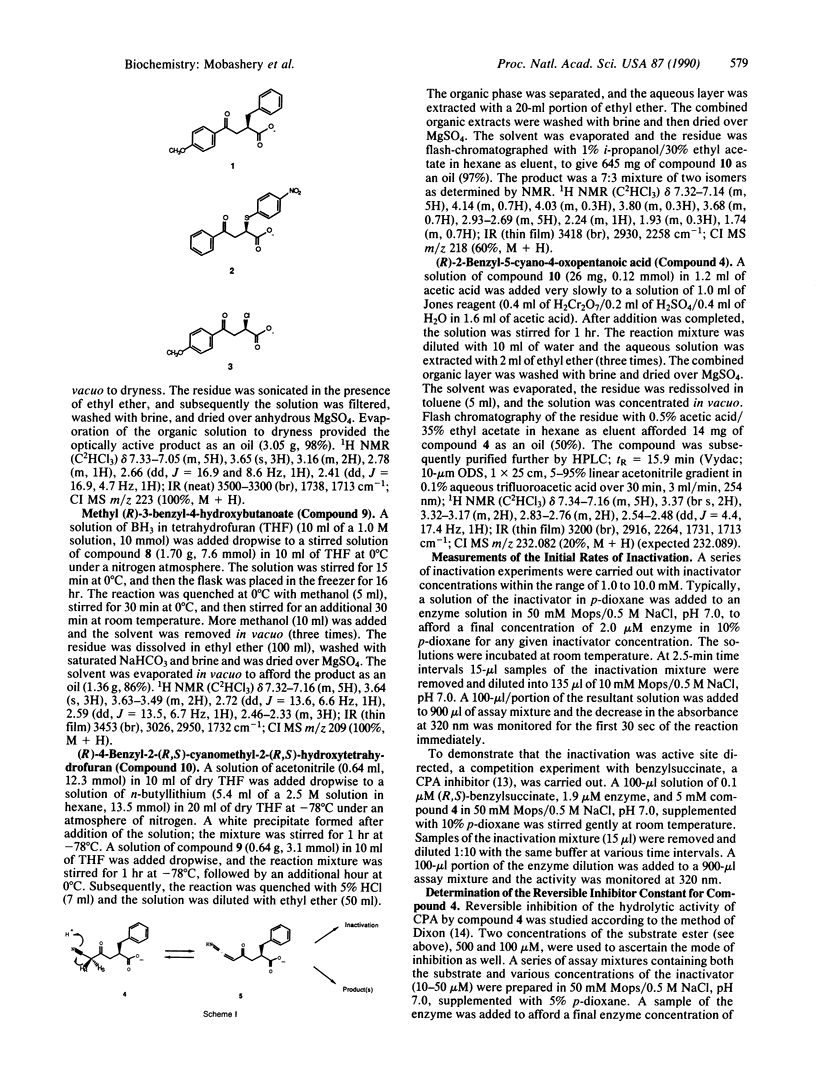
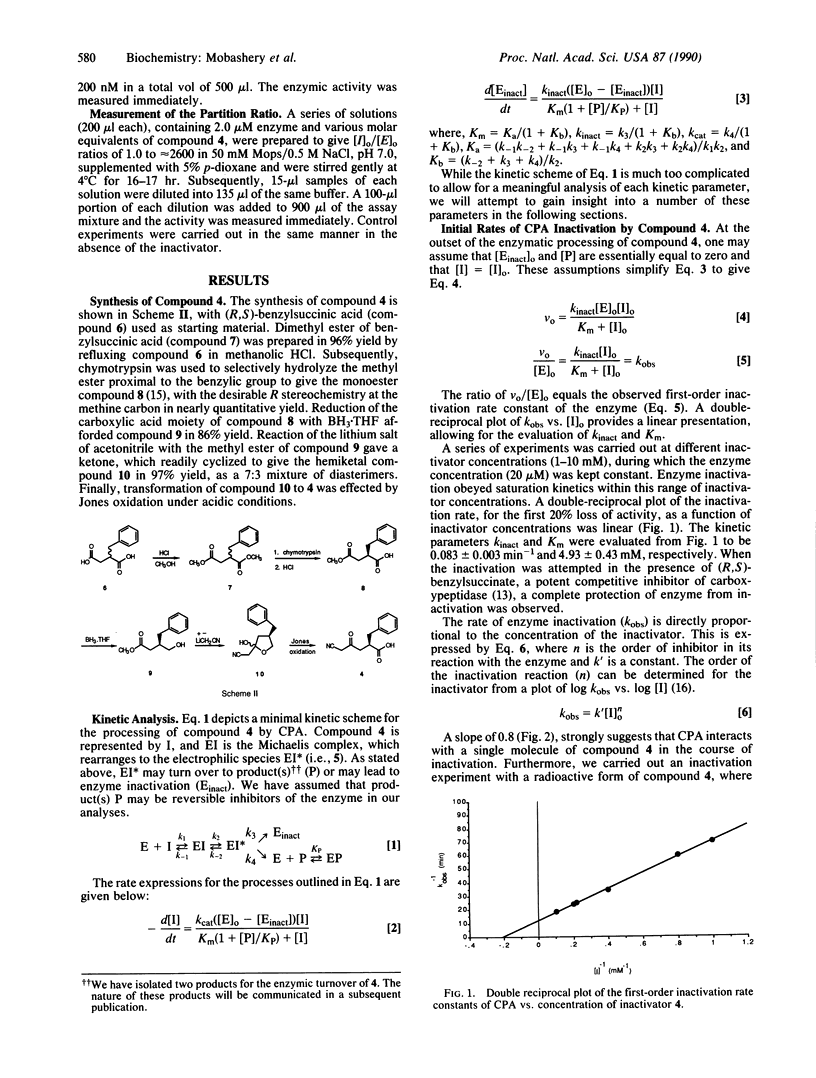
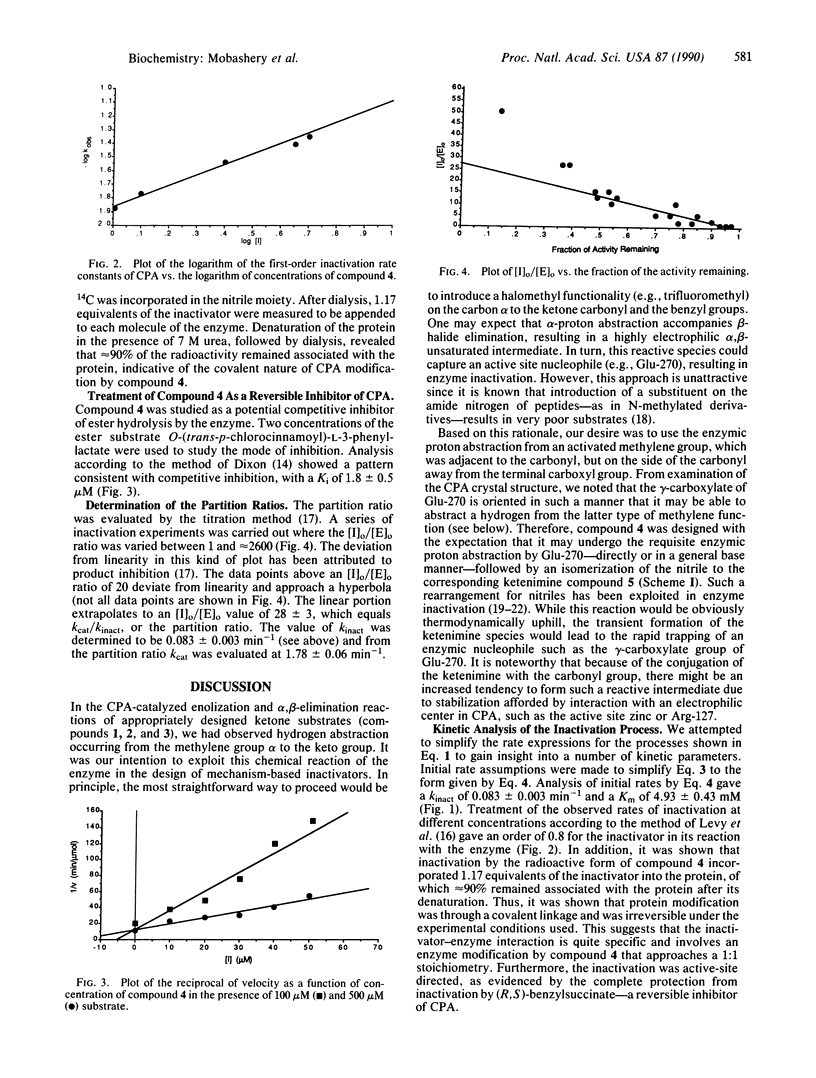
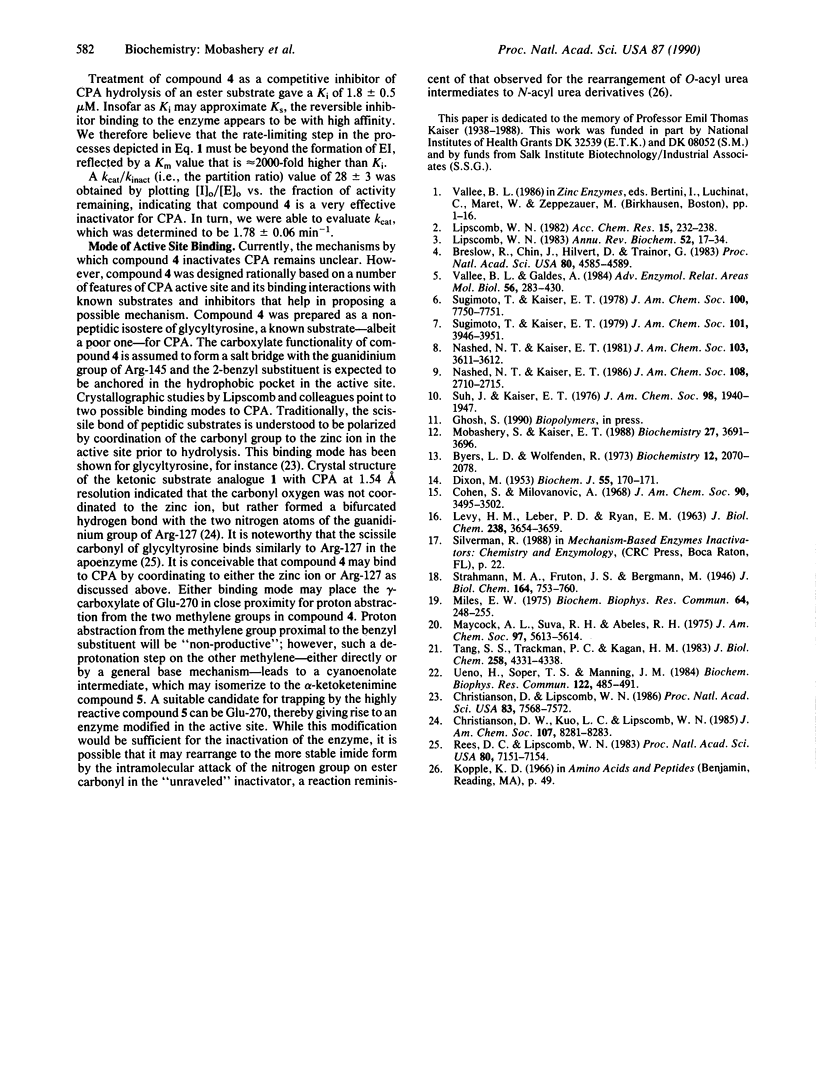
Selected References
These references are in PubMed. This may not be the complete list of references from this article.
- Breslow R., Chin J., Hilvert D., Trainor G. Evidence for the general base mechanism in carboxypeptidase A-catalyzed reactions: partitioning studies on nucleophiles and H2(18)O kinetic isotope effects. Proc Natl Acad Sci U S A. 1983 Jul;80(14):4585–4589. doi: 10.1073/pnas.80.14.4585. [DOI] [PMC free article] [PubMed] [Google Scholar]
- Byers L. D., Wolfenden R. Binding of the by-product analog benzylsuccinic acid by carboxypeptidase A. Biochemistry. 1973 May 22;12(11):2070–2078. doi: 10.1021/bi00735a008. [DOI] [PubMed] [Google Scholar]
- Christianson D. W., Lipscomb W. N. X-ray crystallographic investigation of substrate binding to carboxypeptidase A at subzero temperature. Proc Natl Acad Sci U S A. 1986 Oct;83(20):7568–7572. doi: 10.1073/pnas.83.20.7568. [DOI] [PMC free article] [PubMed] [Google Scholar]
- Cohen S. G., Milovanović A. Absolute steric course of hydrolysis by alpha-chymotrypsin. Esters of alpha-benzylsuccinic, alpha-methyl-beta-phenylpropionic, and alpha-methylsuccinic acids. J Am Chem Soc. 1968 Jun 19;90(13):3495–3502. doi: 10.1021/ja01015a036. [DOI] [PubMed] [Google Scholar]
- DIXON M. The determination of enzyme inhibitor constants. Biochem J. 1953 Aug;55(1):170–171. doi: 10.1042/bj0550170. [DOI] [PMC free article] [PubMed] [Google Scholar]
- LEVY H. M., LEBER P. D., RYAN E. M. INACTIVATION OF MYOSIN BY 2,4-DINITROPHENOL AND PROTECTION BY ADENOSINE TRIPHOSPHATE AND OTHER PHOSPHATE COMPOUNDS. J Biol Chem. 1963 Nov;238:3654–3659. [PubMed] [Google Scholar]
- Lipscomb W. N. Structure and catalysis of enzymes. Annu Rev Biochem. 1983;52:17–34. doi: 10.1146/annurev.bi.52.070183.000313. [DOI] [PubMed] [Google Scholar]
- Maycock A. L., Suva R. H., Abeles R. H. Letter: Novel inactivators of plasma amine oxidase. J Am Chem Soc. 1975 Sep 17;97(19):5613–5614. doi: 10.1021/ja00852a066. [DOI] [PubMed] [Google Scholar]
- Miles E. W. Effects of modification of the beta 2 subunit and of the alpha2beta2 complex of tryptophan synthase by alpha-cyanoglycine, a substrate analog. Biochem Biophys Res Commun. 1975 May 5;64(1):248–255. doi: 10.1016/0006-291x(75)90245-4. [DOI] [PubMed] [Google Scholar]
- Mobashery S., Kaiser E. T. Identification of amino acid residues involved in substrate recognition by the catalytic subunit of bovine cyclic AMP dependent protein kinase: peptide-based affinity labels. Biochemistry. 1988 May 17;27(10):3691–3696. doi: 10.1021/bi00410a025. [DOI] [PubMed] [Google Scholar]
- Rees D. C., Lipscomb W. N. Crystallographic studies on apocarboxypeptidase A and the complex with glycyl-L-tyrosine. Proc Natl Acad Sci U S A. 1983 Dec;80(23):7151–7154. doi: 10.1073/pnas.80.23.7151. [DOI] [PMC free article] [PubMed] [Google Scholar]
- Suh J., Kaiser E. T. pH dependence of the nitrotyrosine-248 and arsanilazotyrosine-248 carboxypeptidase A catalyzed hydrolysis of O-(trans-p-chlorocinnamoyl)-L-beta-phenyllactate. J Am Chem Soc. 1976 Mar 31;98(7):1940–1947. doi: 10.1021/ja00423a048. [DOI] [PubMed] [Google Scholar]
- Tang S. S., Trackman P. C., Kagan H. M. Reaction of aortic lysyl oxidase with beta-aminopropionitrile. J Biol Chem. 1983 Apr 10;258(7):4331–4338. [PubMed] [Google Scholar]
- Ueno H., Soper T. S., Manning J. M. Enzyme-activated inhibition of bacterial D-amino acid transaminase by beta-cyano-D-alanine. Biochem Biophys Res Commun. 1984 Jul 31;122(2):485–491. doi: 10.1016/s0006-291x(84)80059-5. [DOI] [PubMed] [Google Scholar]
- Vallee B. L., Galdes A. The metallobiochemistry of zinc enzymes. Adv Enzymol Relat Areas Mol Biol. 1984;56:283–430. doi: 10.1002/9780470123027.ch5. [DOI] [PubMed] [Google Scholar]


